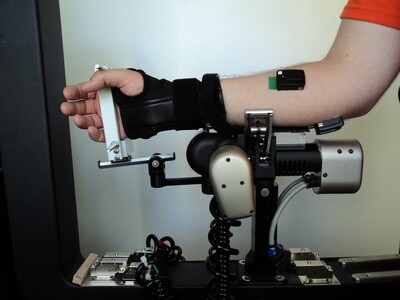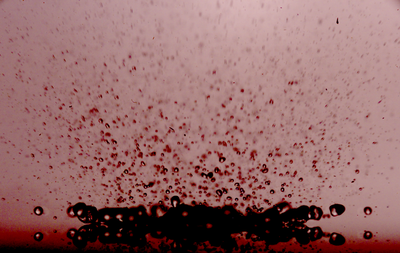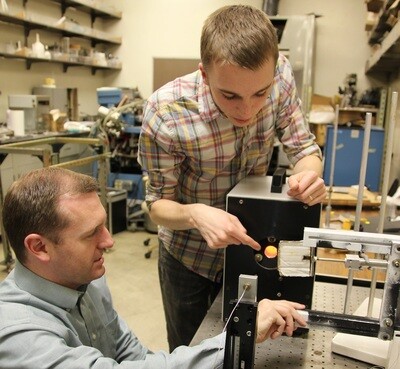Research Areas
Research within the department can be categorized under the following areas of focus:
- Aerospace
- Bioengineering
- Design
- Dynamic Systems, Controls, and Robotics
- Energy Systems and Air Quality
- Fluid Mechanics
- Materials
- Structural Dynamics and Acoustics
- Thermal Transport
Learn about current research projects happening with professors in the department.
Aerospace
Aerospace engineering focuses on flight systems such as aircraft and spacecraft. Applications also include other "flight" systems such as underwater vehicles, wind turbines, and high performance automobiles. Research in the department includes both computational and experimental research across various applications including aircraft, unmanned aerial vehicles, turbomachinery, satellites, airports, and wind turbines.


-
Toggle ItemFaculty with research in this area
- Brad Adams (Air Quality) – Urban air quality modeling; gasifier design.
- Jon Blotter – Aeroacoustics for eVTOL vehicles.
- Julie Crockett – Cavitation on micro/nano propellers.
- Steve Gorrell – Turbomachinery CFD and aerodynamics.
- Larry Howell (CMR) – Foldable space systems using origami mechanisms.
- Dan Maynes – Propeller aerodynamics; turbomachinery modeling.
- Tim McLain – Autonomous UAV control in GPS-denied environments.
- Andrew Ning (FLOW) – eVTOL and wind turbine optimization; low-noise propeller design.
- Hongjuan Ran – Blade optimization in turbomachinery; unsteady flow in reactors.
- John Salmon – UAV systems engineering; autonomous flightpath design.
Bioengineering/Biomechanics
Biomechanics is the application of mechanics to biology and has origins dating back to Aristotle. Biomechanics seeks to understand the mechanics of living systems, from molecules to organisms. Biomechanical engineering is the practical implementation of this understanding, and embodies the attempts of humans to design and develop mechanical devices that mimic, measure, improve, repair, or replace the function of living systems.


-
Toggle ItemFaculty with research in this area
- Anton Bowden – Spine biomechanics sensors; implant design.
- Steven Charles (Neuromechanics Research Group) – Tremor modeling; rehab technologies.
- Christopher Dillon (Bioheat Transfer Lab) – Thermal modeling in MRgFUS therapies; tendon stress.
- David Fullwood (Microstructure Research) – Strain sensors for lower back pain motion monitoring.
- Larry Howell (CMR) – Biomedical compliant mechanisms.
- Brian Jensen – CNTs in bio systems; MEMS; compliant bio-mechanisms.
- Todd Nelson – Flexure-based systems for impact absorption and wearables.
- Benjamin Terry – Swallowable medical capsules; surgical tools.
- Nathan Usevitch – Assistive/prosthetic device design.
Design
Engineering design affects everyday life - everything around us has been designed. Design involves the systematic interplay between creation and validation with the intent to bring useful parts, products, or systems, to the marketplace. Researchers in engineering design develop theories, methodologies, and tools that improve the design process and bring new capabilities to the hands of the mechanical designer. This includes computer aided engineering, systems design, product development, numerical and optimization methods, and the integration of engineering with other disciplines.


-
Toggle ItemFaculty with research in this area
- Steven Charles (Neuromechanics Research Group) – Movement disorder-focused design.
- Douglas Cook (Crop Biomechanics) – Design of robotic and biomechanical plant systems.
- Nathan Crane (CREATE) – Additive manufacturing process and defect design.
- Taylor Greenwood – Soft robots and multi-stable mechanisms.
- Jeff Hill (SMASH) – Impact-absorbing tensegrity designs.
- Larry Howell (CMR) – Origami-based deployable mechanisms.
- Brian Jensen – MEMS; energy-storing compliant mechanisms.
- Oliver Johnson – Design optimization; robotic construction systems.
- Marc Killpack (radlab) – Human-robot interaction design.
- Chris Mattson – Sustainable product design; global development.
- Todd Nelson – Shape-morphing mechanisms; origami for devices.
- Nathan Usevitch – Robotic system design and modeling.
Dynamic Systems, Controls, and Robotics
Many modern engineering systems, including robots, biomedical devices, vehicles, sensors, and machinery are comprised of interconnected dynamic elements. The ability to design, model, and control such systems is essential in modern engineering. Current areas of focus related to dynamic systems and controls at BYU include unmanned air vehicles (UAVs), microelectromechanical systems (MEMS), active noise control, haptic interfaces, and robotics.


-
Toggle ItemFaculty with research in this area
- Matt Allen (SDRG) – Aerospace vibrations; control of bolted joints.
- Douglas Cook (Crop Biomechanics) – Agricultural robotics; plant motion analysis.
- Taylor Greenwood – Actuated soft mechanisms.
- Jeff Hill (SMASH) – Dynamic modeling of tensegrity systems.
- Steven Charles (Neuromechanics) – Human motion analysis.
- Brian Jensen – MEMS design with dynamic applications.
- Oliver Johnson – System modeling; uncertainty quantification.
- Marc Killpack (radlab) – Soft robotics control and learning.
- Tim McLain – Autonomous aircraft systems.
- Brady Moon – Multi-robot coordination; autonomous exploration.
- Nathan Usevitch – Soft robot modeling and control.
Energy Systems and Air Quality
The dual specters of global warming and political instability in oil exporting countries have made the development of sustainable energy systems a national priority. Research in the department spans various aspects of energy engineering and includes collaborations with other departments, industry, and national labs.


-
Toggle ItemFaculty with research in this area
- Brad Adams (Air Quality) – Dust transport, urban air quality, gasifier modeling.
- Brian Iverson (flux) – Radiative cooling; sCO₂ cycles; wetting and boiling.
- Matt Jones – Thermal systems modeling; AM defect mitigation.
- Jason Porter – Energy diagnostics; radiative heat transfer in AM/batteries.
- Dale Tree – Biomass combustion; high-temp emissions testing.
- Troy Munro (TEMP) – Thermal conductivity in nuclear fuels; calorimetry.
- Hongjuan Ran – Thermal hydraulics; renewable turbomachinery.
- John Salmon – Solar/human-powered vehicle systems.
Fluid Mechanics and Thermal Transport
Fluid mechanics deals with the study of liquids and gases at rest or in motion. Research in fluid mechanics focuses on understanding how fluids move and interact with their surroundings over the range of length scales from the nano-scale to the global scale. Fluid mechanics research encompasses many complicated dynamic systems which are solved through a combination of experiments and direct observation, analytical methods, and computational fluid dynamics (CFD). Research topics at BYU are broad and include areas such as: biological flows, micro- and nano-fluidic systems, flow physics in turbomachines, turbulence, fluid-structure interactions, atmospheric and oceanic flow dynamics, aircraft aerodynamics, and reacting flows.


-
Toggle ItemFaculty with research in this area
- Brad Adams – Urban canopy flow; CFD modeling.
- Julie Crockett – Droplet dynamics; cavitation; ocean waves.
- Steve Gorrell – Compressor CFD; flow modeling in turbomachinery.
- Brian Iverson (flux) – Wetting behavior; phase-change heat transfer.
- Dan Maynes – Liquid dynamics on superhydrophobic surfaces.
- Nathan Spiers – Cavitation bubbles; air-water interface dynamics.
- Hongjuan Ran – Reactor and turbomachinery flow problems.
- Dale Tree – Water vapor flow in turbines and combustion systems.
Materials
Progress in materials science is at the heart of most exciting advances in modern engineering. Materials science consists in exploring the relationships between structure, properties and processing operations that define a material. The engineering materials group develops novel processing techniques to prepare advanced materials. We use cutting edge microscopy to determine material structure at the nano-scale. Then, we employ mathematical tools to characterize the structure and properties of the material, and we design even better ones.

-
Toggle ItemFaculty with research in this area
- Anton Bowden – CNT-based spinal implant materials.
- Nathan Crane (CREATE) – Composite AM; defect detection in powder-based AM.
- David Fullwood – Dislocations; metal forming mechanics.
- Eric Homer – Shape memory ceramics; grain boundary modeling.
- Brian Jensen – CNT materials; MEMS; compliant materials.
- Oliver Johnson – Microstructure design; materials informatics.
- Matt Jones – Thermal defect detection in AM.
- Jason Porter – Battery material spectroscopy; porous radiative transfer.
- Troy Munro (TEMP) – Thermal analysis of advanced nuclear materials.
Structural Dynamics and Acoustics
Acoustics research at BYU is strongly cross-disciplinary in character and focuses on the following areas: active noise and vibration control, sound-structure interaction, nonlinear acoustics, audio acoustics and architectural acoustics. The research in acoustics is both experimental and computational in nature and includes simulation and measurement of physical systems, as well as signal processing. Structural dynamics research focuses on modeling and experimental methods to ensure that structures such as aircraft and launch vehicles can survive the dynamic loads that they experience during operation.

-
Toggle ItemFaculty with research in this area
- Matt Allen (SDRG) – Structural vibration modeling for aerospace.
- Jon Blotter – Vibration and acoustic signal detection; optical sensors.
- Jeff Hill (SMASH) – Dynamic tensegrity structures under high impact.
- Todd Nelson – Compliant structures with dynamic folding.
- Larry Howell (CMR) – Robust compliant mechanism dynamics.
- Brian Jensen – MEMS and dynamic compliant mechanisms.
- Nathan Spiers – Cavitation and air-water interaction dynamics.
Thermal Transport
Thermodynamics and Heat and Mass Transfer play a critical role in the design and optimization of energy conversion systems at all length scales (nano-, micro- and meso-scales). At BYU, we investigate methods to enhance and/or control transport of heat and mass to achieve efficient thermal management, chemical reactions and energy systems. Efforts include experimental and analytical approaches and address a host of applications (combustion, aerospace, biosensors, energy harvesting, etc.).


-
Toggle ItemFaculty with research in this area
- Christopher Dillon (Bioheat) – Thermal modeling for medical therapies.
- Nathan Crane (CREATE) – Heat input response in AM processes.
- Eric Homer – Cryogenic grain boundary behavior.
- Brian Iverson (flux) – Radiative heat control; microstructure effect on heat transfer.
- Matt Jones – Thermal modeling and harvesting in energy systems.
- Dan Maynes – Thermal effects of superhydrophobic surfaces.
- Troy Munro – Microscale thermal conductivity; bio-calorimetry.
- Jason Porter – Radiative heat in porous materials and combustion.
- Hongjuan Ran – Heat transfer in reactors and energy storage systems.